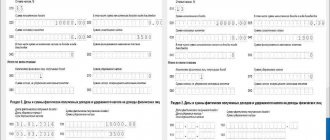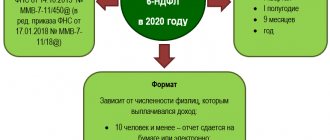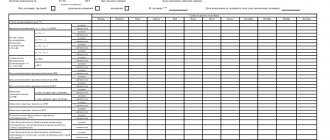Form 1-NDFL
Form 1-NDFL does not comply with the current provisions of the tax legislation of the Russian Federation.
For example, it does not contain information about the dates of payment of income, withholding and transfer of personal income tax to the budget, as well as information about income for accounting at the new progressive rate. Let us remind you! From January 1, 2022, a progressive personal income tax scale was introduced, according to which income over 5 million rubles. per year must be taxed at a rate of 15%. Read about the nuances of reflecting information on income taxed at the new rate in 6-NDFL here.
Form 1-NDFL can be modified to suit you and be maintained as a tax register for personal income tax accounting.
Our experts have identified the most important criteria used in 1-NDFL, and based on them they created a tax register.
1-NDFL is available on our website (see link below).
Information from 1-NDFL is needed mainly to fill out a report on form 6-NDFL. Therefore, you need to group the data so that it is convenient to use when filling out the report.
So, form 1-NDFL contains the following main sections.
General characteristics of the form as a tax register
The document is currently not a mandatory form, previously used as a primary accounting card. At the same time, enterprises must create tax registers for personal income tax. An enterprise has the opportunity to use an independently developed document of any form.
Most taxpayers use 1-NDFL as the most optimal form for recording employee taxation indicators. The form or its modified form is included in the document flow schedule and approved in the annex to the accounting policy. The provisions of the form must be supplemented with information necessary for tax accounting:
- Dates of settlement transactions within a month;
- Indication of the details of documents confirming transactions;
- The amount of income and deductions received during the period from another employer during employment during the year;
- Amounts and grounds for providing social and property types of deductions provided by employers to employees upon notification of the Federal Tax Service.
The information on the form is recorded by the tax agent - the person who pays the employee wages and other payments. Russian organizations, individual entrepreneurs, lawyers and notaries, foreign representative offices paying remuneration to individuals can act as an agent.
Help 1-NDFL, section 1
This section includes basic information about the tax agent (organization), or more precisely, data such as:
- TIN and KPP of the organization acting as a tax agent for personal income tax;
- code of the Federal Tax Service, to which information about the taxpayer will be submitted (as a rule, this is the tax office with which the tax agent organization is registered);
- name of the tax agent and his OKTMO.
It is also advisable to add the company’s OGRN and its telephone number to this section.
This information is used when filling out the title page of form 6-NDFL.
Let us remind you! From 2022, use the new 6-NDFL form. Now it will reflect the information that was previously submitted using the 2-NDFL certificate form.
EXPLANATIONS from ConsultantPlus: The main thing when filling out the 6-NDFL calculation is to carefully transfer data from the tax registers for personal income tax. Therefore, if tax accounting is in order, then filling out the 6-NDFL calculation will not be difficult... ConsultantPlus experts told us how to fill out the calculation correctly. To do everything correctly, get trial access to the system and go to the Ready solution. It's free.
Step-by-step instructions for filling out form 1-NDFL
The form contains several sections for entering information on different types of appointment.
| Chapter | Content | Composition of information |
| 1 | Information about the company, tax agent | Name of the enterprise, OKTMO, INN, KPP, registration number, contact phone number, Federal Tax Service code |
| 2 | Employee information | Full name, Taxpayer Identification Number if available, SNILS number, passport details, place of actual residence, resident status, availability of declared deductions |
| 3 | Calculation of the tax base | The section is devoted to tax base indicators. Data on accrued income is reflected by month |
| 4 | Information on dividends received | The section information contains dividends paid, the amount of tax, as well as arrears of payment |
| 5 | Information about taxation at the rate of 35% | The section contains data on the tax base, deductions, taxes and debts of the person |
| 6 | Total tax amount | The information reflects the total amount of calculated and withheld tax at all rates, broken down by indicator, as well as the person’s debt |
| 7 | Income taxed by the Federal Tax Service | This section is filled in as needed. |
| 8 | Recalculation of indicators | Includes data on errors from previous periods that require recalculation of the base or tax |
| 9 | Information about the certificates provided | Contains information about certificates issued by the Federal Tax Service and the taxpayer, information about the person |
Help 1-NDFL, section 2
This section displays information about the individual taxpayer to whom the organization paid income and withheld personal income tax. The following data is presented on it:
- TIN of an individual taxpayer in Russia and country of citizenship;
- FULL NAME.;
- Date of Birth;
- identity document and its code;
- citizenship with country code;
- data on the number of days of stay in the Russian Federation (to determine tax status (resident, non-resident) for each month of the tax period).
This information is needed to fill out section 1 of Appendix No. 1 to the calculation of 6-NDFL.
Help 1-NDFL, section 3
In this part of 1-NDFL, the personal income tax tax base is directly calculated at rates of 13%, 15% and 30% (13% is the basic rate in the Russian Federation, 15% is a progressive rate for income over 5 million rubles, and 30% is income rate for non-residents).
In form 1-NDFL, the form contains a table in which the indicators by income code are summarized monthly for the entire year and the deductions provided are also indicated monthly.
Income codes for the 2-NDFL certificate can be found in our article “List of income codes in the 2-NDFL certificate (2012, 4800, etc.)” .
After this, the tax base is formed in 1-NDFL and the personal income tax is calculated. The tax withheld is indicated. Tax debts are identified, taking into account debts at the beginning of the year.
It is advisable to add to this section 1-NDFL:
- dates of receipt of income;
- tax withholding dates;
- dates of tax payment to the budget;
- information about the payment document for tax transfer;
- information about tax deductions by their types (standard, social, property, professional, investment), codes, amounts for each month of the tax period and the grounds for their application;
- split the line containing the tax base into several lines, heading them something like this: - “The main tax base (from the beginning of the year) for the income of a resident of the Russian Federation specified in paragraphs. 9 clause 2.1, clause 3 art. 210 of the Tax Code of the Russian Federation" - it needs to be broken down to indicate amounts within 5 million rubles, over 5 million rubles. and the total size of the tax base;
— “The tax base determined in relation to the income of a tax non-resident of the Russian Federation specified in paragraph. 3 - 7 p. 3 tbsp. 224 of the Tax Code of the Russian Federation" - it needs to be broken down to indicate amounts within 5 million rubles, over 5 million rubles. and the total size of the tax base;— “Tax base (from the beginning of the year) for the income of a non-resident of the Russian Federation specified in paragraphs. 8 clause 2.2 art. 210 Tax Code of the Russian Federation";
- provide lines to indicate the amount of tax calculated from each of these tax bases separately;
- information on the amount of fixed advance payments paid by foreign citizens, accepted as a reduction in the amount of calculated tax;
- information on the grounds for reducing the calculated amount of tax by the amount of fixed advance payments paid by the foreign taxpayer (details of the notification from the Federal Tax Service, the taxpayer’s application, details of the document on payment of fixed advance payments).
An example of filling out Form 1-NDFL when an employee’s income exceeds 5 million rubles. prepared by ConsultantPlus experts. You can get a free trial demo access to the system:
Filling procedure
When applying for a job, an employee is required to provide the necessary information about himself, which is entered into his personal card and stored in the personnel department or accounting department. Then, when calculating wages, a 1-NDFL register is created for each employee. It is filled out according to the information specified in the employee’s personal card. If any individual employee data is missing, it is necessary to clarify it.
In general, entering information into the register does not differ from the usual filling out of a 1-NDFL tax card. There you need to carry all the taxpayer’s data, the amount of income and the amount of tax deduction required by law and confirmed by the relevant documents. It is also necessary to indicate the date and serial number of the document according to which the funds were transferred.
The register must be completed by the employer or the employer's representative. It is also the responsibility of the employer to submit tax documents.
Applicable codes
When filling out the 1-NDFL tax card, special income and deduction codes are used. The most commonly used income codes are:
- 2000 – accrued and paid wages, as well as bonuses and other payments;
- 2012 – payment of vacation pay to the taxpayer;
- 2300 – payment of sick leave;
- 2400 – income received from rentals, vehicles associated with the transportation of goods, as well as from the rental of various pipelines, power lines, computer networks, etc.;
- 1400 – transfer by lease of certain property, except for transport and communications;
- 2760 – paid financial assistance to working or retired employees;
- 4800 – other payments, including for unused days of vacation provided by law.
In more detail, you can see the list of codes most often used when filling out documents in Appendix No. 1, Federal Tax Service Regulation dated September 10, 2015.
Deduction codes that should be used to fill out the 1-NDFL register:
- The so-called “children’s” standard deductions from numbers 114 to 125 inclusive;
- Property: numbers 311, 312;
- Social: Nos. 320, 321,324;
- Professional: No. 403-405 inclusive;
- Special deductions, within certain limits: No. 501, 503, 505,508.
You can read more about deduction codes in Appendix No. 2, Order of the Federal Tax Service dated September 10, 2015.
Filling example
Form 1-NDFL is filled out for the tax office in 9 sections. They indicate information about the income and deductions of an individual who is an employee of the organization.
In section 1 you should indicate information about the employer, such as:
- Code of the tax office to which the employer belongs;
- TIN of the company and its KPP and OGRN;
- Legal address and telephone number of the company;
- Full name of the organization.
The second section should contain the details of the individual for whom the company or entrepreneur pays taxes. In the case where the employee is a resident of another country, it is necessary to indicate his exact address in his home country with the country code.
The third section of the report contains information about the tax base on which income tax will be calculated. This information should be entered into a table that shows:
- Amount of income;
- The amount of accrued taxes;
- The total amount of deductions due and confirmed by documents;
- The amount of taxes accrued and paid.
Further:
- The next section is dividends. Here you can see the amount of dividends received and the amount of accrued tax at a rate of 9%.
- The fifth section reflects types of income taxed at an increased rate of 35% and related to winnings in lotteries and competitions.
- The next sections 6 and 7 are final by types of taxes and income. Here you need to indicate the amount of deductions.
- The final section is devoted to adjustments and recalculations of previous erasures. After the modifications have been made, you need to make an additional payment to the budget or make a request for a refund of overpaid amounts to the tax office.
The document is signed by the manager and endorsed with the seal of the enterprise.
You can download the form here.
Sample of filling out 1-NDFL
Help 1-NDFL, section 4
This section 1-NDFL contains information on accrued and paid dividends, as well as on the calculated and withheld amount of personal income tax and tax debts. This section in the register being developed does not need to be used, since all this information can be indicated in section 3 according to the corresponding income code.
We recommend making the following changes to it:
- add new lines:
- income code;
- date of receipt of income;
- date of payment of income;
- tax withholding date;
- tax payment date;
- details of the payment document for tax transfer;
2. enter separate lines for tax calculated at rates of 13% and 15%.
For clarifications from the Federal Tax Service of the Russian Federation on the procedure for reflecting dividends in personal income tax reporting, read the material “How to reflect dividends in form 6-NDFL”.
Help 1-NDFL, section 5
This section lists all income taxed at a rate of 35%.
The table is maintained for each income code, taking into account a deduction in the amount of 4,000 rubles, provided for in clause 28 of Art. 217 Tax Code of the Russian Federation. Then the tax base is formed, then the amount of tax calculated and withheld, as well as tax debts, are indicated.
It would be useful to indicate in this section 1-NDFL and the dates of receipt of income, tax withholding, the date of payment of taxes with data on the payment document.
Information not to be included in the document data
The document does not reflect information about non-taxable payments, which include:
- Payments upon birth of a child and care benefits;
- Travel allowances in the form of daily allowances;
- Rations and compensation for sub-rental housing;
- Other payments within the limits established by regional legislation;
- Amounts of compensation provided for by internal regulations.
Payments that are exempt from taxation within the limit are reflected in 1-NDFL in full. The deductible limit is established for financial assistance, gifts, prizes, daily payments as part of travel expenses.
An example of a record of gifts given to an employee
Employee S. of the organization LLC “Team” received a gift from the employer for the company’s day worth 8,500 rubles. In accounting for S. and 1-NDFL remuneration in the month of receiving the gift, the following is indicated:
- The value of the gift received is 8,500 rubles;
- Deduction code 501 for non-taxable personal income tax in the amount of 4,000 rubles (clause 28 of article 217 of the Tax Code of the Russian Federation).
The card reflects the full amount, taxable and non-taxable, as well as the code and amount of the deduction.
Help 1-NDFL, section 6
This section summarizes all personal income tax rates calculated in previous sections based on the results of the tax period (year).
Let's abolish ineffective rates in 1-NDFL, leaving only those that are relevant today: 13, 30 and 35%. The section indicates the total amount of tax for the year - calculated, withheld, transferred for collection to the tax authority. Recalculation for previous tax periods is also taken into account, and debts at the end of the period are shown.
It is recommended to add this section:
- date of receipt of income;
- date of tax calculation;
- tax withholding date;
- tax payment deadline;
- date of actual tax payment;
- KBK and OKTMO, according to which the tax is transferred.
Read more about the current personal income tax rates in the article “ What percentage is personal income tax? " .
How to generate a certificate of income and personal income tax amounts for an employee in 1C programs?
From 01/01/2021, the employer is obliged to issue the employee a certificate of income and tax amounts in a new form in accordance with the order of the Federal Tax Service of Russia dated 10/15/2020 No. ED-7-/753.
In this article we will tell you how to create a certificate for an employee in “1C: Salaries and Personnel Management 8” (rev. 3) and in “1C: Accounting 8” (rev. 3.0).
Generating a certificate of income and personal income tax amounts for an employee in the 1C: ZUP 3 program
To draw up a certificate of income and tax amounts of an individual issued to employees, the document “2-NDFL for employees” is intended.
1. Section “Taxes and contributions” - “All documents on personal income tax”
2. Create button.
3. In the “Year” field, select the year for which the information is generated.
4. In the “Employee” field, select an employee from the “Individuals” directory who needs to generate a certificate of his income and tax amounts.
5. In the “Generate” field, select “Summary” if you need to create a single statement of all employee income for submission, for example, to a bank or other organizations and institutions. Select “By OKTMO/KPP codes and tax rates” if you need to create a certificate in the context of OKTMO/KPP codes specified in the OKTMO/KPP field and tax rates.
6. In the OKTMO/KPP field, only those OKTMO/KPP are offered for which there is registered income of an individual; OKTMO/KPP is automatically selected according to the last place of receipt of income. When generating a “summary” certificate, this list is also supplemented by the registration of the parent organization, even if there was no income from it.
7. In the Federal Tax Service field, the code of the tax authority where the organization, separate division or territory is registered is automatically indicated. The Federal Tax Service code is also indicated in the “Registration with the Tax Authority” directory.
8. In the “Date” field, indicate the date the certificate was prepared.
9. On the tabs 13%, 30%, 35%, 15%, 9%, 10%, 5%, the tabular part displays monthly income accrued to an individual, taxed accordingly at tax rates of 13%, 30%, 35%, 15 %, 9%, 10%, 5% and deductions provided.
10. The other tabular part displays the tax deductions provided.
11. The “Income Amounts” and “Tax Amounts” sections display the income and tax amounts for each tab.
12. The “Personal Data” tab displays data about the individual for whom a certificate of income and tax amount is being prepared.
13. At the bottom of the document form, under the “Signatures” link, in the fields “Signed”, “Position”, “Telephone”, full name is automatically indicated. and the position of the person who signs this certificate, and telephone number.
14. “Pass” button.
15. To check the correctness of the filled data, you can use the built-in check using the “Check” button
16. To generate and print a certificate of income and tax amounts for an individual, use the “Certificate of Income” button (2-NDFL)
Generating a certificate of income and personal income tax amounts for an employee in the 1C:BP 3.0 program
To draw up a certificate of income and tax amounts of an individual issued to employees, the document “Certificate of Income (2-NDFL) for employees” is intended.
1. Section “Salaries and Personnel” - “2-NDFL for employees”.
2. “Create” button.
3. In the “Year” field, select the year for which the information is generated.
4. In the “Employee” field, indicate the employee from the “Individuals” directory who needs to generate a certificate of his income and tax amounts.
5. In the “Generate” field, select “Summary” if you need to create a single statement of all employee income for submission, for example, to a bank or other organizations and institutions. Select “By OKTMO/KPP codes and tax rates” if the certificate is prepared for the specified combination of OKTMO and KPP in the OKTMO/KPP and tax rates field.
6. In the “OKTMO/KPP” field, the OKTMO/KPP of the selected organization is automatically indicated.
7. In the “IFTS” field, the code of the tax authority where the organization or separate division is registered is automatically indicated.
8. In the “Date” field, indicate the date the certificate was prepared.
9. On the tabs 13%, 30%, 35%, 15%, 9%, 10%, 5%, the tabular part displays monthly income accrued to an individual, taxed accordingly at tax rates of 13%, 30%, 35%, 15 %, 9%, 10%, 5% and deductions provided. Income taxed at 10% and 5% rates is entered manually.
10. The other tabular part displays the tax deductions provided.
11. The “Income Amounts” and “Tax Amounts” sections display the income and tax amounts for each tab.
12. The “Personal Data” tab displays data about the individual for whom the income certificate is being prepared.
13. At the bottom of the document form, click on the “Signatures” link in the “Signed”, “Position”, “Telephone” fields, indicate your full name. and the position of the person who signs this certificate, and telephone number.
14. “Pass” button.
15. To check the correctness of the filled data, you can use the built-in check using the “Check” button.
16. To generate and print a certificate of income and tax amounts for an individual, use the “Certificate of Income” button (2-NDFL)
Results
Today's legislation does not require maintaining 1-NDFL for each employee throughout the year. But in accordance with Art. 230 of the Tax Code of the Russian Federation, an organization must maintain tax registers, which it needs to develop independently. To simplify the creation of tax registers, it is most advisable to download form 1-NDFL, modify it according to our recommendations for each section and fill out the resulting register for each individual to whom the organization paid income.
You can read about maintaining a tax register for personal income tax and download a sample of it in our article “How is a tax register for personal income tax maintained?”
You can find more complete information on the topic in ConsultantPlus. Free trial access to the system for 2 days.
Register form
To start using the 1-NDFL accounting register, you need to open the template of this document in an accounting program and apply it to your company. In the case when you want to develop it yourself, you can take the previously used form 1-NDFL as a basis.
The register must contain the following information:
- Last name, first name, patronymic of the employee;
- Date, month and year of birth;
- employee tax identification number;
- Resident or non-resident. This item is necessary because it allows you to calculate the tax rate correctly;
- The total amount of income paid to the employee. It is necessary to indicate income codes and the date of payment of salaries;
- Total number of tax deductions. Here it is also worth noting the codes according to which the deductions were made. We further indicate the amount of income minus the required deduction;
- The total amount of taxes that was calculated and deducted from the salary. The day on which this amount was deducted from the salary and the day on which the tax was transferred. The reasons for the transfer are also indicated, i.e. number and payment number.
The register is filled out for each employee separately. Some enterprises with a small staff practice maintaining a general 1-NDFL register. This is possible, but in order to avoid unnecessary problems when submitting declarations or when checking by regulatory authorities, it is more advisable to find time and still fill out registers for each employee.







